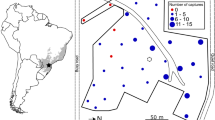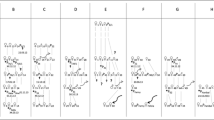Abstract
The modes of intrasexual competition interacting in many dispersed societies of nocturnal solitary foragers are still poorly understood. In this study we investigate the spatial structure within a free-living population of gray mouse lemurs (Microcebus murinus) in order to test for the first time the predictions from two contrasting models of male intrasexual competition on the population level. The contest competition model predicts an uneven distribution of the sexes in a population nucleus with a female biased sex ratio in the center and a male biased sex ratio in the periphery. In contrast the scramble competition model predicts males and females being distributed evenly throughout their habitat with a constant sex ratio. Nine capture/recapture periods within three consecutive mating seasons revealed a continuous male biased sex ratio in the adult population with even trapping rates for the sexes. The male biased sex ratio could either be explained with postnatal female biased mortality or with a male biased natal sex ratio. This male biased sex ratio was apparent in all parts of the study site, indicating that the population was not subdivided into a female biased core and a male biased periphery. Furthermore, the majority of adult males have been captured at the same site as or in vicinity to females. Consequently, a large proportion of males had spatial access to females during the mating season. No signs of monopolization of females by certain dominant males could be detected. These data support the predictions from the scramble competition model and the concept of a promiscuous mating system for this species.
Similar content being viewed by others
References
Alcock, J. 1980. Natural selection and the mating systems of solitary bees.Amer. Sci., 68: 146–153.
Atsalis, S. 2000. Spatial distribution and population composition of the brown mouse lemur (Microcebus rufus) in Ranomafana National Park, Madagascar, and its implications for social organization.Amer. J. Primatol., 51: 61–78.
Bearder, S. K. 1987. Lorises, bushbabies, and tarsiers: diverse societies in solitary foragers. In:Primate Societies,Smuts,B. B.;Cheney,D. L.;Seyfarth,R. M.;Wrangham,R. W.;Struhsaker,T. T. (eds.), The Univ. of Chicago Press, Chicago, pp. 11–24.
Bearder, S. K. 1999. Physical and social diversity among nocturnal primates: a new view based on long term research.Primates, 40: 267–282.
Charles-Dominique, P. 1978. Solitary and gregarious prosimians: evolution of social structures in primates. In:Recent Advances in Primatology, Vol. 3: Evolution,Chivers,D. J.;Joysey,K. A. (eds.), Academic Press, London, New York, San Francisco, pp. 139–149.
Cheney, D. L.;Wrangham, R. W. 1987. Predation. In:Primate Societies,Smuts,B. B.;Cheney,D. L.;Seyfarth,R. M.;Wrangham,R. W.;Struhsaker,T. T. (eds.), The Univ. of Chicago Press, Chicago, pp. 227–239.
Clark, A. B. 1978. Sex ratio and local resource competition in a Prosimian primate.Science, 201: 163–165.
Clutton-Brock, T. H. 1984. Size, sexual dimorphism, and polygyny in primates. In:Size and Scaling in Primate Biology,Jungers,W. L. (ed.), Plenum Press, New York, pp. 51–60.
Clutton-Brock, T. H. 1989. Mammalian mating systems.Proc. R. Soc. Lond. B, 236: 339–372.
Clutton-Brock, T. H.;Harvey, P. H. 1977. Primate ecology and social organization.J. Zool. Lond., 183: 1–39.
Clutton-Brock, T. H.;Harvey, P. H. 1978. Mammals, resources and reproductive strategies.Nature, 273: 191–195.
Clutton-Brock, T. H.;Parker, G. A. 1992. Potential reproductive rates and the operation of sexual selection.Quart. Rev. Biol., 67: 437–456.
Dewsbury, D. A. 1982. Dominance rank, copulatory behavior, and differential reproduction.Quart. Rev. Biol., 57: 135–159.
Dice, L. R. 1945. Measures of the amount of ecologic association between species.Ecology, 26: 297–302.
Emlen, S. T.;Oring, L. W. 1977. Ecology, sexual selection, and the evolution of mating systems.Science, 197: 215–223.
Fietz, J. 1998. Body mass in wildMicrocebus murinus over the dry season.Folia Primatol., 69: 183–190.
Fietz, J. 1999. Mating system ofMicrocebus murinus.Amer. J. Primatol., 48: 127–133.
Ganzhorn, J. 1988. Food partitioning among Malagasy primates.Oecologia, 75: 436–450.
Ganzhorn, J. U. 1995. Low-level forest disturbance effects on primary production, leaf chemistry, and lemur populations.Ecology, 76: 2084–2096.
Ganzhorn, J. U.;Schmid, J. 1998. Different population dynamics ofMicrocebus murinus in primary and secondary deciduous dry forests of Madagascar.Int. J. Primatol., 19: 785–796.
Greenwood, J. J. D. 1996. Basic techniques. In:Ecological Census Techniques,Sutherland,W. J. (ed.), Cambridge Univ. Press, Cambridge, pp. 11–110.
Harvey, P. H.;Harcourt, A. H. 1984. Sperm competition, testes size, and breeding systems in primates. In:Sperm Competition and the Evolution of Animal Mating Systems,Smith,R. L. (ed.), Academic Press, New York, pp. 589–600.
Hubalek, Z. 1982. Coefficients of association and similarity, based on binary (presence-absence) data: an evaluation.Biol. Rev., 57: 669–689.
Ims, R. A. 1988. Spatial clumping of sexually receptive females induces space sharing among male voles.Nature, 335: 541–543.
Kappeler, P. M. 1997a. Determinants of primate social organization: comparative evidence and new insights from Malagasy lemurs.Biol. Rev., 72: 111–151.
Kappeler, P. M. 1997b. Intrasexual selection inMirza coquereli: evidence for scramble competition polygyny in a solitary primate.Behav. Ecol. Sociobiol., 45: 115–127.
Krebs, C. J. 1989.Ecological Methodology. Harper Collins, New York.
Lebec, A. 1984. Relation entre le comportement agressif du Microcèbe mâle, les autres comportements et la physiologie secuelle. Rôle de quelques facteurs déterminants. Thèse 3ème Cycle, Paris Univ. VI.
Ludwig, D. 1984.Microtus richardsoni microhabitats and life history. In:Winter Ecology of Small Mammals,Merrit, J. F. (ed.), Spec. Publ. Carnegie Mus. Natl. Hist. 10, pp. 319–331.
Martin, R. D. 1972. A preliminary field-study of the lesser mouse lemur (Microcebus murinus J. F. Miller 1777).Z. Tierpsychol., 9: 43–89.
Martin, R. D. 1973. A review of the behaviour and ecology of the lesser mouse lemur (Microcebus murinus). In:Comparative Ecology and Behaviour of Primates,Michael,R. P.;Crook,J. H. (eds.), Academic Press, London, pp. 1–68.
Martin, R. D. 1995. Prosimians: from obscurity to extinction? In:Creatures of the Dark: The Nocturnal Prosimians,Alterman,L.;Doyle,G. A.;Izard,M. K. (eds.), Plenum Press, New York, pp. 535–564.
Mittermeier, R. A.;Tattersall, I.;Konstant, W. R.;Meyers, D. M.;Mast, R. B. 1994.Lemurs of Madagascar. Conservation International, Washington, D.C.
Møller, A. P. 1988. Ejaculate quality, testes size and sperm competition in primates.J. Human Evol., 17: 479–488.
Nunn, C. L. 1999. The number of males in primate social groups: a comparative test of the socioecological model.Behav. Ecol. Sociobiol., 46: 1–13.
Pagés-Feuillade, E. 1988. Modalités de l’occupation de l’espace et relations interindividuelles chez un prosimien nocturne malgache (Microcebus murinus).Folia Primatol., 50: 204–220.
Parker, G. A. 1984. Sperm competition and the evolution of animal mating strategies. In:Sperm Competition and the Evolution of Animal Mating Systems,Smigh,R. L. (ed.), Academic Press, Orlando, pp. 1–60.
Perret, M. 1982. Influence du groupement social sur la reproduction de la femelle deMicrocebus murinus (Miller, 1777).Z. Tierpsychol., 60: 47–65.
Perret, M. 1990. Influence of social factors on sex ratio at birth, maternal investment and young survival in a prosimian primate.Behav. Ecol. Sociobiol., 27: 447–454.
Perret, M. 1992. Environmental and social determinants of sexual function in the male lesser mouse lemur (Microcebus murinus).Folia Primatol., 59: 1–25.
Perret, M.;Colas, S. 1997. Manipulation of sex ratio at birth and maternal investment in female mouse lemurs (Microcebus murinus, Primates).App. Anim. Behav. Sci., 51: 275–283.
Peters, C. 1999. Intrasexuelle Konkurrenz bei grauen Mausmaki-Männchen (Microcebus murinus) in Nordwest-Madagaskar. Diploma thesis, Univ. of Göttingen, Göttingen.
Petrusewicz, K.;Andrezejewski, R. 1962. Natural history of the free-living population of house mice (Mus musculus L.) with particular reference to groupings within the population.Ecologia Polska, Series A, 10: 85–122.
Plavcan, J. M.;van Schaik, C. P. 1997. Intrasexual competition and body weight dimorphism in anthropoid primates.Amer. J. Phys. Anthropol., 87: 461–477.
Radespiel, U. 1998. Die soziale Organisation des grauen Mausmakis (Microcebus murinus, J. F.Miller 1777): eine frilandökologische und laborexperimentelle Studie. Ph.D. thesis, Univ. of Hannover, Hannover.
Radespiel, U. 2000. Sociality in the grey mouse lemur (Microcebus murinus) in northwestern Madagascar.Amer. J. Primatol., 51: 21–40.
Radespiel, U.;Cepok, S.;Zimmermann, E.;Zietemann, V. 1998. Sex-specific usage patterns of sleeping-sites in Grey Mouse Lemurs (Microcebus murinus) in Northwestern Madagascar.Amer. J. Primatol., 4: 77–84.
Rasoloarison, R. M.;Goodman, S. M.;Ganzhorn, J. U. 2001. Taxonomic revision of mouse lemurs (Microcebus) in the western portions of Madagascar.Int. J. Primatol., 21: 693–1020.
Ridley, M. 1986. The number of males in a primate troop.Anim. Behav., 34: 1848–1858.
Sarikaya, Z. 1999. Fortpflanzungsstrategien von Weibchen des grauen Mausmakis (Microcebus murinus) in Nordwest-Madagaskar. Diploma thesis, Univ. of Göttingen, Göttingen.
Schmelting, B.;Ehresmann, P.;Lutermann, H.;Randrianambinina, B.;Zimmermann, E. 2000. Reproduction of two sympatric mouse lemur species (Microcebus murinus andM. ravelobensis) in north-west Madagascar: first results of a long term study. In:Diversity and Endemism in Madagascar,Lurenço,W. R.;Goodman,S. M. (eds.), Mémoires de la Societé de Biogeographie, Paris, pp. 1–12.
Schmid, J. 1997. Torpor beim Grauen Mausmaki (Microcebus murinus) in Madagaskar: energetische konsequenzen und ökologische bedeutung. Ph.D. thesis, Univ. of Tübingen, Tübingen.
Schmid, J.;Kappeler, P. M. 1998. Fluctuating sexual dimorphism and differential hibernation by sex in a primate, the gray mouse lemur (Microcebus murinus).Behav. Ecol. Sociobiol., 43: 125–132.
Schwab, D. 2000. A preliminary study of spatial distribution and mating system of pygmy mouse lemurs (Microcebus cf myoxinus).Amer. J. Primatol., 51: 41–60.
Schwagmeyer, P.L. 1988. Scramble-competition polygyny in an asocial mammal: male mobility and mating success.Amer. Naturalist, 131: 885–892.
Schwagmeyer, P. L.;Woontner, S. J. 1986. Scramble competition polygyny in thirteen-lined ground squirrels: the relative contributions of overt conflict and competitive mate searching.Behav. Ecol. Sociobiol., 19: 359–364.
Siegel, S.;Castellan, N. J. Jr. 1988.Nonparametric Statistics for the Behavioral Sciences. McGraw-Hill Book, New York.
Stockley, P.;Searle, J. B.;MacDonald, D. W.;Jones, C. S. 1994. Alternative reproductive tactics in male common shrews: relationships between mate-searching behaviour, sperm production, and reproductive success as revealed by DNA fingerprinting.Behav. Ecol. Sociobiol., 34: 71–78.
Terborgh, J.;Janson, C. H. 1986. The socioecology of primate groups.Ann. Rev. Ecol. Syst., 17: 111–135.
Tew, T. E.;MacDonald, D. W. 1994. Dynamics of space use and male vigour amongst wood mice,Apodemus sylvaticus, in the cereal ecosystem.Behav. Ecol. Sociobiol., 34: 337–345.
Trivers, R. L. 1972. Parental investment and sexual selection. In:Sexual Selection and the Descent of Man 1871–1971,Campbell,B. (ed.), Aldine, Chicago, pp. 136–179.
van Hooff, J. A. R. A. M.;van Schaik, C. P. 1992. Cooperation in competition: the ecology of primate bonds. In:Coalitions and Alliances in Humans and Other Animals,Harcourt,A. H.;de Waal,F. B. M. (eds.), Oxford Univ. Press, Oxford, pp. 357–389.
van Schaik, C. P.;van Hooff, J. A. R. A. M. 1983. On the ultimate causes of primate social systems.Behaviour, 85: 91–117.
Wells, K. 1977. The social behaviour of anuran amphibians.Anim. Behav., 25: 666–693.
Yoder, A. D.;Rasoloarison, R. M.;Goodman, S. M.;Irwin, J. A.;Atsalis, S.;Ravosa, M. J.;Ganzhorn, J. U. 2000. Remarkable species diversity in malagasy mouse lemurs (Primates,Microcebus).PNAS, 97: 11325–11330.
Zimmermann, E. 1995. Acoustic communication in nocturnal prosimians. In:Creatures of the Dark,Alterman,L.;Doyle,G. A.;Izard,M. K. (eds.), Plenum Press, New York & London, pp. 311–330.
Zimmermann, E.;Cepok, S.;Rakotoarison, N.;Zietemann, V.;Radespiel, U. 1998. Sympatric mouse lemurs in North-West Madagascar: a new rufous mouse lemur species (Microcebus ravelobensis).Folia Primatol., 69: 106–114.
Author information
Authors and Affiliations
About this article
Cite this article
Radespiel, U., Ehresmann, P. & Zimmermann, E. Contest versus scramble competition for mates: The composition and spatial structure of a population of gray mouse lemurs (Microcebus murinus) in North-west Madagascar. Primates 42, 207–220 (2001). https://doi.org/10.1007/BF02629637
Received:
Accepted:
Issue Date:
DOI: https://doi.org/10.1007/BF02629637




